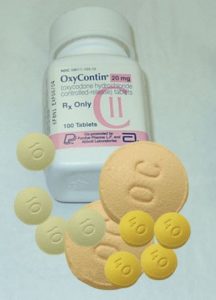Oxycontin
 OxyContin is one of the newer long acting and powerful prescription pain medications for patients who suffer from moderate pain. A long acting form of Oxycodone, it comes in 10, 20, 40, 80 and 160 mg time-release tablets. Potentially addictive, OxyContin is being diverted for use as a substitute for heroin. There have been many reported deaths from the illegal use of this drug. As of March 29, 2001 there were 59 reported deaths in Kentucky and 10 reported deaths in Maine. An 18 year old Philadelphia man died after taking only one-half of a 40 milligram tablet. As of April 16, 2001 there were 120 deaths nation wide attributed to OxyContin or OxyContin in combination with other drugs or alcohol. There will be many more deaths as this drug which started in the east coast moves west at an alarming rate. Much of the abuse can be attributed to physicians writing unnecessary prescriptions. Another reason OxyContin is so popular is because unlike heroin, OxyContin is manufactured under scientific and sterile conditions by highly skilled people with the exact dose noted on each tablet. The user knows exactly how much of the drug he is getting unlike with heroin where the strength is unknown.
OxyContin is one of the newer long acting and powerful prescription pain medications for patients who suffer from moderate pain. A long acting form of Oxycodone, it comes in 10, 20, 40, 80 and 160 mg time-release tablets. Potentially addictive, OxyContin is being diverted for use as a substitute for heroin. There have been many reported deaths from the illegal use of this drug. As of March 29, 2001 there were 59 reported deaths in Kentucky and 10 reported deaths in Maine. An 18 year old Philadelphia man died after taking only one-half of a 40 milligram tablet. As of April 16, 2001 there were 120 deaths nation wide attributed to OxyContin or OxyContin in combination with other drugs or alcohol. There will be many more deaths as this drug which started in the east coast moves west at an alarming rate. Much of the abuse can be attributed to physicians writing unnecessary prescriptions. Another reason OxyContin is so popular is because unlike heroin, OxyContin is manufactured under scientific and sterile conditions by highly skilled people with the exact dose noted on each tablet. The user knows exactly how much of the drug he is getting unlike with heroin where the strength is unknown.
Oxycodone is synthesized from thebaine. It is similar to codeine, but is more potent and has a higher dependence potential. It is effective orally and is marketed in combination with aspirin (Percodan) or acetaminophen (Percocet) for the relief of pain. Designed as time-release tablets, addicts and other users take the tablets and crush them into powder and take the drug orally or dissolve it in water, filter out the insoluble material, and “mainline” the active drug which no longer has a time-release feature.
July, 2001 – after a rash of armed robberies at pharmacies by drug dealers and users looking for OxyContin, officials at some New England supermarket chains said they will stop stocking the drug in its pharmacies in an effort to protect its customers and employees from potential harm.
Effects of OxyContin are similar to heroin or morphine. (Euphoria, sleepy, tired) One pharmacist described OxyContin as a drug that is as close to heroin as you can get. OxyContin is a respiratory depressant. When used with other depressants like alcohol or other depressant drugs you have the accumulative effect makes which causes your breathing to stop, cardiovascular system stops functioning, your heart stops and then you die.”
As of August 2001, Purdue Pharma LP, the distributor of OxyContin advised that they are modifying the drug so that if the tablets are crushed a chemical will neutralize the narcotic effect. The science behind this has not been released.
Street names:
Oxy, OC Killer.
Symptoms of Overdose:
Slow breathing
Seizures
Dizziness
Weakness
Loss of consciousness
Coma
Confusion
Tiredness
Cold Clammy Skin
Small Pupils
Side Effects:
Constipation
Dryness of the mouth
Confusion
Alteration of mental status, Sedation
Light-headedness
Respiratory Depression
Nausea
Vomiting
Headache
Sweating
OxyContin delivers the narcotic oxycodone to patients battling pain from cancer or other debilitating conditions. Oxycodone itself is nothing new – it’s been used in a variety of painkillers including Percodan and Percocet since the early 1960s. However, OxyContin contains a much higher concentration of the drug that, like heroin, is derived from opium.













Connect
Connect with us on the following social media platforms.